What is information design? And in a world where, slowly but surely, everything is being translated into, and expressed as, information, how do you begin to think about organizing the massive amounts of information we’re generating every day? What are the most successful strategies for thinking with, manipulating and organizing information?
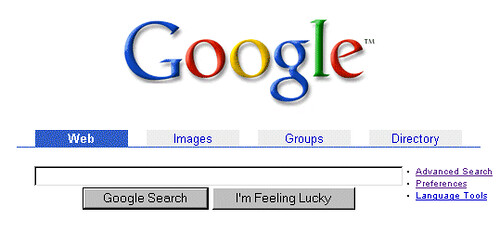
Google, one of the superstars of the information age, has recognized something important: that the internet does not need to be organized until you want to ask it a question. The entire Google business model is built around this premise: just-in-time organization. As soon as you have a question, Google will attempt to organize all available information in rank order, from most relevant to least relevant.
This would seem to be an ideal method for organizing information, and Google’s business success is a testament to this.
You can think of a question as a tool that you can use to increase your knowledge or reduce uncertainty. In fact, a question may be the most basic tool for gaining knowledge and working with information. If this is so, then it makes sense to ask which kinds of questions are best suited to different kinds of information challenges. A set of standard questions that can be applied consistently to different situations might form the basis of a standard toolkit for information discovery and design.
Q-tools
The list below attempts to define a set of “Q-tools” that may be used to generate, sort, classify and perform operations on information. This is not intended to be an exhaustive list, but more of a starting point for discussion. I have also added some alternative names for each Q-tool.
 A prism is a question that divides information into smaller groups. The purpose of a prism is to break down information into categories or subgroups. An example might be “What are the parts of this system?” Prisms are used extensively in scientific inquiry. They are also used in organization design to map the departments and sub-departments of a company. An example question used in this activity might be “What roles are required to deliver this functionality?” To create a prism, define a question that can be used to divide a unit of information into its constituent parts. Alternative names: Divider, separator, splitter, brancher.
A prism is a question that divides information into smaller groups. The purpose of a prism is to break down information into categories or subgroups. An example might be “What are the parts of this system?” Prisms are used extensively in scientific inquiry. They are also used in organization design to map the departments and sub-departments of a company. An example question used in this activity might be “What roles are required to deliver this functionality?” To create a prism, define a question that can be used to divide a unit of information into its constituent parts. Alternative names: Divider, separator, splitter, brancher.
Examples:
“What are the components?”
“What is it made of?”
“What resources are required to make this happen?”
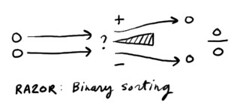 A razor is a question that divides information into two categories, based on relevance. The purpose of a razor is to define a boundary which can be used to sort any incoming information , and determine whether it lies inside our outside the boundary. A simple example: “Is this information relevant to me right now?” Productivity expert David Allen uses razors such as “Is it actionable?” as a method to process inbox information and increase productivity. A razor can also be used to sort things into rank order by asking of any two items “Which is more important?” To create a razor, define a question that can be answered only two ways, such as yes/no, or in/out. Alternative names: Cutter, fin, blade.
A razor is a question that divides information into two categories, based on relevance. The purpose of a razor is to define a boundary which can be used to sort any incoming information , and determine whether it lies inside our outside the boundary. A simple example: “Is this information relevant to me right now?” Productivity expert David Allen uses razors such as “Is it actionable?” as a method to process inbox information and increase productivity. A razor can also be used to sort things into rank order by asking of any two items “Which is more important?” To create a razor, define a question that can be answered only two ways, such as yes/no, or in/out. Alternative names: Cutter, fin, blade.
Examples:
“Is this relevant to the issue at hand?”
“Can it be used to…?”
“Can you eat it?”
“Can you find it in a grocery store?”
“Can it be used to make a cake?”
“Which is more important?”
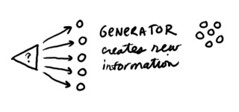 A generator is a question that has a potentially unlimited number of answers. The purpose of a generator is to explore new or unknown territory and to find knowledge that may be hidden and make it explicit. An example might be “What kinds of things are possible?” Open questions are used by inventors to stimulate discovery, for example: “How might we transport sound over great distances?” To create a generator, define a question that has an unlimited set of possible answers. Alternative names: Spout, spring, opener.
A generator is a question that has a potentially unlimited number of answers. The purpose of a generator is to explore new or unknown territory and to find knowledge that may be hidden and make it explicit. An example might be “What kinds of things are possible?” Open questions are used by inventors to stimulate discovery, for example: “How might we transport sound over great distances?” To create a generator, define a question that has an unlimited set of possible answers. Alternative names: Spout, spring, opener.
Examples:
“How might we…?”
“What might happen if…?”
“What kinds of things could…?”
“What is the meaning of life?”
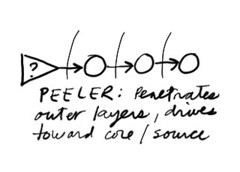 A peeler is a single question that, when repeated, drives attention to deeper and deeper levels, like the peeling of an onion. The purpose of a peeler is to penetrate beyond superficial levels in order to get to the heart of the matter. An example might be “Why?” Taiichi Ono, the designer of Toyota’s production system, described “Five whys” as the basis of Toyota’s approach, because by the time you have asked why five times, the nature of the problem as well as its solution becomes clear. But a peeler does not have to use the word “why.” Another peeler results from using the question “How does that work?” This approach has served science for many years and has led to deeper and deeper levels of the onion, from atoms to particles and beyond [Is it fair to call this reductionism?]. To create a peeler, define a single question that can be asked repeatedly to drive to deeper and deeper levels of an issue. Alternative names: Ladder, drill, hammer, spike, repeater.
A peeler is a single question that, when repeated, drives attention to deeper and deeper levels, like the peeling of an onion. The purpose of a peeler is to penetrate beyond superficial levels in order to get to the heart of the matter. An example might be “Why?” Taiichi Ono, the designer of Toyota’s production system, described “Five whys” as the basis of Toyota’s approach, because by the time you have asked why five times, the nature of the problem as well as its solution becomes clear. But a peeler does not have to use the word “why.” Another peeler results from using the question “How does that work?” This approach has served science for many years and has led to deeper and deeper levels of the onion, from atoms to particles and beyond [Is it fair to call this reductionism?]. To create a peeler, define a single question that can be asked repeatedly to drive to deeper and deeper levels of an issue. Alternative names: Ladder, drill, hammer, spike, repeater.
Examples:
“What else?”
“And?”
“So what?” (For developing a selling story)
 A flanker is a question that seeks patterns or ideas that are similar. The purpose of a flanker is to think laterally and find an analogous situation that may help you think about things differently. An example might be “How might you approach this problem if you were a chef?” Flankers are used to break out of existing thought patterns that may cause blind spots. To create a flanker, define a question that approaches your situation from an oblique or unexpected angle. Flanker may be a subcategory of generator. Alternative names: Similator, Analogizer, slider, sider, shifter, sidestepper, lateral.
A flanker is a question that seeks patterns or ideas that are similar. The purpose of a flanker is to think laterally and find an analogous situation that may help you think about things differently. An example might be “How might you approach this problem if you were a chef?” Flankers are used to break out of existing thought patterns that may cause blind spots. To create a flanker, define a question that approaches your situation from an oblique or unexpected angle. Flanker may be a subcategory of generator. Alternative names: Similator, Analogizer, slider, sider, shifter, sidestepper, lateral.
Examples:
“How might this look from the opposite side?”
“What would we do if we wanted to create this problem instead of solve it?”
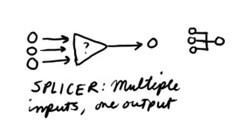 A splicer is a question that combines information, or sets, into groups. The purpose of a splicer is to find larger categories and simplify collections of information. An example might be “What do these things have in common?” Splicers are used to classify information and build hierarchical information structures. For example, any invertebrate animal that has four pairs of legs, no antennae and no wings may be considered as a members of a single class which we call arachnids. Splicers are also used in a process called affinity mapping, a process designed to find similarities in large groups of information. Another example might be “What things feel like they belong together?” To create a splicer, define a question that can be used to find commonality. Alternative names: Merger, on-ramp, combiner, fuser.
A splicer is a question that combines information, or sets, into groups. The purpose of a splicer is to find larger categories and simplify collections of information. An example might be “What do these things have in common?” Splicers are used to classify information and build hierarchical information structures. For example, any invertebrate animal that has four pairs of legs, no antennae and no wings may be considered as a members of a single class which we call arachnids. Splicers are also used in a process called affinity mapping, a process designed to find similarities in large groups of information. Another example might be “What things feel like they belong together?” To create a splicer, define a question that can be used to find commonality. Alternative names: Merger, on-ramp, combiner, fuser.
Examples:
“What are the similarities?”
“What group does this belong to?”
A pointer is a question that has a well-defined or broadly agreed-upon answer, or set of answers. The purpose of a pointer is to gather specific information, for example: “What is your name?” Pointers are used extensively to collect information for the purposes of comparison and quantitative analysis. Census data would be an example. To create a pointer, define a question that is likely to have one, and only one, answer. Alternative names: Finder, getter, coupler.
Examples:
“What is your gender?”
“How old are you?”
“What is your primary address?”
“How many languages do you speak?”
Other Q-tools that might be worth exploring:
The essay question is particularly interesting. I think there’s a benefit to a tool whose purpose is to generate a story or narrative. For example, “Tell me about a time when…”
Another might be an estimator, to use when you need to make an educated guess. Such cases are quite common in business, because most business plans are actually a combination of goals and educated guesses. Budgets, agendas and project plans are examples. An example of an estimator might be “How much will this cost?”
Another way that q-tools can be useful is to help define the purpose of a question. For example, “What is the scope of the project” could be a generator (open question, exploratory) or it could be a pointer (specific request for information). There are many occasions when a pointer could look like a generator and vice versa, causing a lot of potential confusion. Common use of q-tools would make such distinctions explicit.
1. The questions we use in tests and school might be worth exploring:
– a. Word problem
– b. Essay question
– c. Multiple choice
– d. True/false (falls under razor)
2. The Zen koan, exploring the nature of paradox
3. The riddle
I’d appreciate any thoughts that you have for additional Q-tools, as well as your thoughts about what they might be called. It seems to me that tool names should reflect the use of the tool as much as possible (a drill drills, a screwdriver drives screws, a hammer hammers, etc.). I have chosen the names with that in mind.
I’ll try to keep this list updated as new Q-tools are defined.
Update: Q-tools are mentioned in “Formality in sketches and informal representation: Some informal reflections” and I was listed as an author. My first academic paper!
